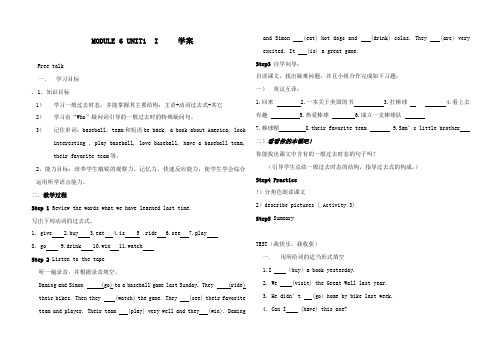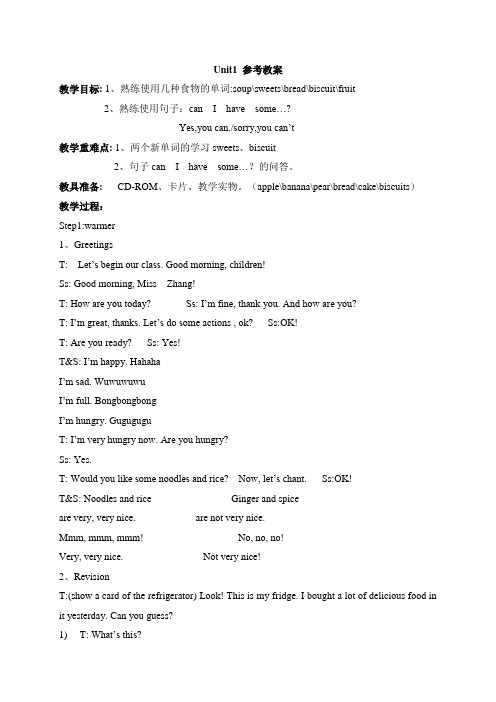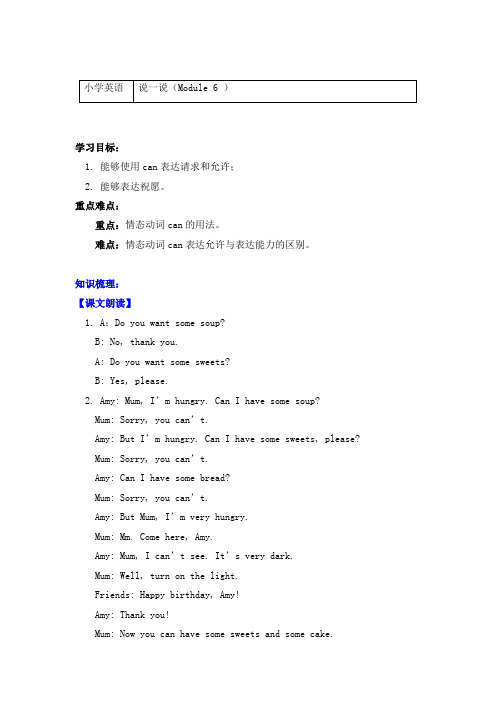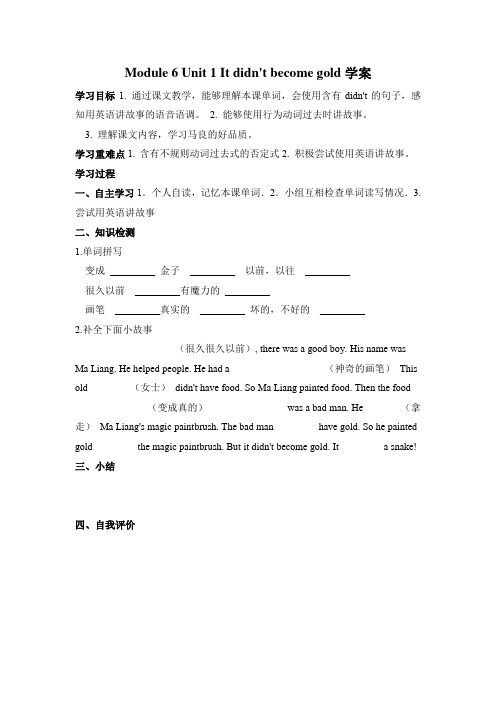英语四年级上册学一学(Module 6)-导学案-外研版(三起)
- 格式:doc
- 大小:364.43 KB
- 文档页数:7

MODULE 6 UNIT1 I 学案Free talk一.学习目标. 1、知识目标1)学习一般过去时态,并能掌握其主要结构:主语+动词过去式+其它2)学习由“Who”疑问词引导的一般过去时的特殊疑问句。
3)记住单词:baseball,team和短语be back, a book about America, look interesting , play baseball, love baseball, have a baseball team,their favorite team等。
2、能力目标:培养学生敏锐的观察力、记忆力,快速反应能力;使学生学会综合运用所学语言能力。
二.教学过程Step 1 Review the words what we have learned last time.写出下列动词的过去式。
1. give2.buy3.eat4.is 5 .ride 6.see 7.play8. go 9.drink 10.win 11.watchStep 2 Listen to the tape听一遍录音,并根据录音填空。
Daming and Simon (go) to a baseball game last Sunday. They (ride) their bikes. Then they (watch) the game. They (see) their favorite team and player. Their team (play) very well and they (win). Damingand Simon (eat) hot dogs and (drink) colas. They (are) very excited. It (is) a great game.Step3 自学向导:自读课文,找出疑难问题,并且小组合作完成如下习题:一)英汉互译:1.回来2.一本关于美国的书3.打棒球4.看上去有趣 5.热爱棒球 6.成立一支棒球队7.棒球帽 8.their favorite team 9.Sam’s little brother 二)看看你的本领吧!你能找出课文中含有的一般过去时态的句子吗?(引导学生总结一般过去时态的结构,指导过去式的构成。

四年级上册英语教案 Module6 U1教案教材简介本节课是《外研社小学英语三年级上册》中的第六模块,本单元共有两个课时(Unit1&2)。
在第一个单元中,学生将学习如何询问和回答自己家庭成员的职业。
教学目标1.能够听懂、理解并正确模仿自己和他人询问家庭成员职业的话语;2.能够听懂并正确使用句型:“What does your father/mother do? He/She is a …”;3.能够说出自己家庭成员的职业;4.能够简单描述一个家庭成员的职业。
教学重点1.句型:“What does your father/mother do? He/She is a …”;2.掌握家庭成员职业的名称。
教学难点1.能够简单描述一个家庭成员的职业。
教学准备1.纸板、白板、笔;2.大纸片、眼镜蛇信封等小道具;3.相关课件和课件投影仪。
教学过程Part 1 自我介绍1.教师向学生进行简单的自我介绍;2.要求学生模仿自己,逐个进行自我介绍。
Part 2 大声说出句子1.展示英文句子“What does your father/mother do? He/She is a …”;2.让学生大声说出句子,并告诉他们要注意语音、语调和发音;3.教师朗读一遍或两遍句子,让学生理解句意。
Part 3 英汉互译练习1.向学生展示不同种类职业的图片,并告诉他们职业的名称;2.让学生模仿朗读职业名称,并进行汉英互译练习。
Part 4 单词填空练习1.向学生展示一些有空格的句子,让他们根据上下文和自己的印象填空,并帮助他们纠正错误;2.让学生练习模仿句子,读出完整的句子。
Part 5 小组讨论活动1.将全班分为若干个小组;2.每组其中一个人描述自己家庭成员的职业,然后其他组员猜测;3.帮助学生回答问题并补充描述细节。
Part 6 教师展示1.教师展示一个自己家庭成员的职业;2.让学生用句子“What does your … do? He/She is a …”来询问和回答。

Unit1 参考教案教学目标: 1、熟练使用几种食物的单词:soup\sweets\bread\biscuit\fruit2、熟练使用句子:can I have some…?Yes,you can./sorry,you can’t教学重难点: 1、两个新单词的学习sweets、biscuit2、句子can I have some…?的问答。
教具准备: CD-ROM、卡片、教学实物。
(apple\banana\pear\bread\cake\biscuits)教学过程:Step1:warmer1、GreetingsT: Let’s begin our class. Good morning, children!Ss: Good morning, Miss Zhang!T: How are you today? Ss: I’m fine, thank you. And how are you?T: I’m great, thanks. Let’s do som e actions , ok? Ss:OK!T: Are you ready? Ss: Yes!T&S: I’m happy. HahahaI’m sad. WuwuwuwuI’m full. BongbongbongI’m hungry. GuguguguT: I’m very hungry now. Are you hungry?Ss: Yes.T: Would you like some noodles and rice? Now, let’s chant. Ss:OK!T&S: Noodles and rice Ginger and spiceare very, very nice. are not very nice.Mmm, mmm, mmm! No, no, no!Very, very nice. Not very nice!2、RevisionT:(show a card of the refrigerator) Look! This is my fridge. I bought a lot of delicious food in it yesterday. Can you guess?1) T: What’s this?Ss: A box of milk.T: Yes, you’re right. Look, it’s a box of milk.Ss: Milk.2) T: Can you guess?Ss: Peanuts.3) T: What’s this?Ss: It’s a fish.4)T&Ss: Oh, vegetables.3、Lead inT: Now, look at me. I can jump high. Can you jump high? S1: Yes, I can. T: Can you jump far/run fast? Ss: Yes, I can.T: Can I run fast ? (故意做的很慢)Ss: Sorr y, you can’t.T: Can I run fast ? (故意做的很快) Ss: Yes, you can.T: Today we’re going to learn Unit 1 Can I have some sweets? (板书)Step2: Presentation1)T: Look, boys and girls !Today is Dudu’s birthday.(toy dog)Can you guess what it wants to eat?2) T: le t’s make a chant for the food.Biscuits and sweets Bread ,soup,cakeare very very nice. are also very nice.Mmm, mmm, mmm! Mmm, mmm, mmm!Very, very nice. Also very nice.3) T:I didn‘t have breakfast this morning.I’m very hungry now.Can I have some sweets? (板书)Can I have some…?S1: Can I have some sweets?Yes, you can.T: Yes, you can. Here you are.S2: Can I have some sweets?T: Yes, you can.S3: Can I have some sweetT: Sorry, you can’t. There aren’t any sweets.(板书)Sorry, you can't.Step3: Practice1)Pair work2)Play a gameT: Boys and girls, let’s play a game – Lucky animals, ok?Ss: OK!T: Look ,lost of delicious food. Do you like them?Ss: Yes.T: Do you want to have them? Ss: Yes.T: You can use “Can I have some…?” to tell us wha t you want to have. Then you can choose one of animal . There is a piece of paper behind the card. You can get the answer from it.e.g. S1: Can I have some biscuits?S1 chooses a dog.S2: Yes, you can.Step4: Read text1)T: I heard Amy’s on birthday, too. Let’s go and have a look. Please open your books and turn to page 34. Listen to the tape and then answer my questions.Q1: Who is hungry? Q2: What did Amy ask?Q3: What did Ms Smart say?S1: Amy is hungry. S2: Can I have some sweets?S3: Sorry , you can’t.在学习难点句子时,老师利用肢体语言帮助学生理解句意,Turn on the light .(做开灯的动作)I can’t see . It’s very dark.(双手伸出做摸的动作),师生共同边做动作边说这些句子。

四年级上册英语教案Module6 Unit1——外研社(三起)一、教学内容本节课为四年级上册英语Module6 Unit1,教学内容围绕“Jobs”这一主题展开。
学生将通过学习,掌握不同职业的英语表达,如“teacher”, “doctor”, “driver”等,并能够简单描述不同职业的特点和工作内容。
二、教学目标1. 知识与技能:学生能够正确认读并运用关于职业的单词和句型。
2. 过程与方法:通过小组合作、情景模拟等教学方法,提高学生的英语听说能力和合作能力。
3. 情感态度与价值观:培养学生对不同职业的尊重和认识,激发学生对英语学习的兴趣。
三、教学难点1. 正确发音和记忆职业相关单词。
2. 运用句型描述不同职业的特点和工作内容。
四、教具学具准备1. 教具:多媒体课件、图片、卡片。
2. 学具:学生自备笔记本、彩色笔。
五、教学过程1. 导入:通过展示不同职业的图片,引导学生猜测并说出职业名称,激发学生学习兴趣。
2. 新课呈现:利用多媒体课件,展示本节课的重点单词和句型,教师领读并解释含义。
3. 实践活动:学生分组,每组选择一个职业,用英语描述该职业的特点和工作内容,并进行角色扮演。
4. 巩固练习:通过游戏、竞赛等形式,巩固学生对单词和句型的掌握。
六、板书设计1. 职业单词:teacher, doctor, driver, nurse, cook, farmer, etc.2. 句型:What does your mother/father do? She/He is a3. 情景描述:My mother is a teacher. She teaches English.七、作业设计1.抄写并默写本节课所学的职业单词。
2.用英语描述自己父母的职业,并简单介绍他们的工作内容。
3.预习下一节课的内容。
八、课后反思本节课通过多种教学方法,使学生能够较好地掌握关于职业的单词和句型。
但在教学过程中,部分学生的发音不够准确,需要在今后的教学中加强语音训练。

学习目标:1. 能够使用can表达请求和允许;2. 能够表达祝愿。
重点难点:重点:情态动词can的用法。
难点:情态动词can表达允许与表达能力的区别。
知识梳理:【课文朗读】1. A:Do you want some soup?B: No, thank you.A: Do you want some sweets?B: Yes, please.2. Amy: Mum, I’m hungry. Can I have some soup?Mum: Sorry, you can’t.Amy: But I’m hungry. Can I have some sweets, please? Mum: Sorry, you can’t.Amy: Can I have some bread?Mum: Sorry, you can’t.Amy: But Mum, I’m very hungry.Mum: Mm. Come here, Amy.Amy: Mum, I can’t see. It’s very dark.Mum: Well, turn on the light.Friends: Happy birthday, Amy!Amy: Thank you!Mum: Now you can have some sweets and some cake.Amy: Thank you, Mum.3. Daming: Can I have some soup, Mum?Mum: Sorry, you can’t.Now you can have some sweets and some cake. Happy birthday, Daming.4. A: Today is Halloween!Hello! Can I come in?B: Oh! Hello! Yes, of course.A: Can I have some sweets?B: Here you are.A: Thank you! Whoops!B: Happy Halloween, Tom!【句子赏析】1. Do you want some soup? 你想要点汤吗?Do / Does+人称+ want+东西。

Module 6 Unit 1 It didn't become gold学案学习目标1. 通过课文教学,能够理解本课单词,会使用含有didn't的句子,感知用英语讲故事的语音语调。
2. 能够使用行为动词过去时讲故事。
3. 理解课文内容,学习马良的好品质。
学习重难点1.含有不规则动词过去式的否定式2. 积极尝试使用英语讲故事。
学习过程一、自主学习1.个人自读,记忆本课单词.2.小组互相检查单词读写情况.3. 尝试用英语讲故事二、知识检测1.单词拼写变成_________ 金子_________ 以前,以往_________很久以前_________有魔力的_________画笔_________真实的_________ 坏的,不好的_________2.补全下面小故事____________________(很久很久以前), there was a good boy. His name was Ma Liang. He helped people. He had a _______ ___________(神奇的画笔)This old ________(女士)didn't have food. So Ma Liang painted food. Then the food _______ _______(变成真的)________ _______ was a bad man. He _______(拿走)Ma Liang's magic paintbrush. The bad man ________ have gold. So he painted gold ________ the magic paintbrush. But it didn't become gold. It ________ a snake!三、小结四、自我评价。
外研版四年级上册英语Module 6 AbilitiesUnit 1 can you run fast?一.Teaching and learning aims:1. 能听懂,会说本单元的重点词组:run fast jump high jump far ride fast2. 会运用本单元的重点句型:Can you …? Yes, I can. No, I can’t.3. 会将本单元的句型应用到实际中去。
二.Important and difficult point1. Important points: can的一般疑问句及肯定与否定回答。
2. Difficult points: can的一般疑问句的应用。
三.Teaching Methods1. 教法:情景法、对话法、教师身势语、小组竞赛法等。
2. 学法:通过游戏、小组讨论及各种形式的问答。
四.Teaching Tools通过多媒体、录音机、卡片等手段进行教学。
五.Teaching stepsstep1. warming-up1.师生见面问候,打招呼。
2.Have a chant,提高学生学习英语的兴趣。
Step2. Presentation1.复习旧短语,教师做一个打篮球的动作说: I can play basketball.引出情态动词can,接着用这些短语练习can的肯定句。
2.教师作动作:run fast.说I can run fast. 巩固单词,学习短语run fast.用同样方法教学 jump high、jump far、ride fast 三个短语。
3.教师作动作说:I can run fast, Can you run fast? 引出Can you run fast? 并领读。
接着问:Can you run fast? 学生能跑的快回答Yes, I can. 跑不快回答No, I can’t. 教师领读肯定与否定回答。
4.用刚学过的四个短语练习can的一般疑问问及肯定与否定回答。
四年级上册英语Module6 Unit1 教案第一课时教学目标:1.掌握单词及短语:sweet, soup, sorry, bread, dark, turn on, light2.掌握句型:Can I have…? 回答用:Yes, you can. /Sorry, you can’t.3.能积极主动地去学习英语,大胆开口,积极参与各项学学习活动。
教学重难点:掌握情态动词can 引导的一般疑问句句型以及相关回答。
教学方法:讲授法,演示法,讨论法,创设情境法,自主探究法。
教学过程:Step 1: Review (PPT)Review the words:(师说英语,生说汉语.)sweets 糖果soup 汤sorry 抱歉,对不起bread 面包dark 黑暗的well (语气词)噢turn on 打开light 灯Review the sentences:Do you want some soup? No,thank you.Do you want some sweets? Yes, please.Step 2: Lead-in出示PPT,以卖火柴的小女孩为主题,给大家讲述一下,导入课题,板书,带领学生齐读。
Step 3: 出示学习目标1、能正确认读单词:sweets ,dark, bread ,soup ,sorry ,turn on light .2、能熟练掌握句型:Can I have some…?Yes, you can.Sorry, you can’t.3、能够听懂、会读本课对话。
Step 4: Presentation1.讲一讲:Can I have some …? 我能吃一些…吗?Yes, you can. 是的,你能。
Sorry, you can’t. 对不起,你不能。
(出示几组食物图片,练习一下此句型。
)2.出示自学提示一:(1).Listen, point, and find “can”.a. 看动画,快速从文中找出can 引导的一般疑问句及答语,领读,指名读,齐读。
四年级上册英语教案Module 6 U1 教案外研社三起教学内容本节课为外研社三起四年级上册英语第六模块第一单元,主要围绕“家庭成员”这一主题展开。
教学内容包括学习家庭成员的英文表达,如father, mother, brother, sister等,以及如何用英语介绍家庭成员。
通过本节课的学习,学生能够掌握基本的家庭成员词汇,并能用所学词汇进行简单的英语介绍。
教学目标1. 知识目标:学生能够听懂、会说、会读本节课所学的家庭成员词汇,并能用英语简单介绍家庭成员。
2. 能力目标:培养学生运用英语进行家庭成员介绍的能力,提高学生的英语听说能力。
3. 情感目标:培养学生对家庭的热爱,增进家庭成员间的感情。
教学难点1. 家族成员词汇的发音和记忆。
2. 如何用英语介绍家庭成员。
教具学具准备1. 多媒体课件2. 教学卡片3. 彩色笔教学过程1. 导入:通过展示家庭成员图片,引导学生复习已学的家庭成员词汇,为新课的学习做好铺垫。
2. 新课呈现:利用多媒体课件呈现本节课的主要教学内容,包括家庭成员的英文表达和介绍。
教师引导学生跟读并模仿发音,确保学生正确掌握所学知识。
3. 操练:通过游戏、角色扮演等形式,让学生在轻松愉快的氛围中巩固所学知识。
教师巡回指导,及时纠正发音错误。
4. 应用:学生分组进行家庭成员介绍,用英语描述自己的家庭成员。
教师点评并给予鼓励。
板书设计1. Module 6 Unit 1 Family Members2. 主要教学内容:家庭成员词汇、介绍家庭成员的句型3. 重点:词汇发音、句型结构作业设计1.抄写本节课所学的家庭成员词汇,每个单词写5遍。
2.用所学词汇写一篇关于自己家庭成员的英语短文。
课后反思本节课通过多媒体课件、游戏、角色扮演等多种教学手段,使学生在轻松愉快的氛围中掌握了家庭成员的英文表达和介绍。
但在教学过程中,部分学生对家庭成员词汇的发音掌握不够准确,需要在今后的教学中加强语音训练。
Module6 Unit1 教案【内容来源】外研版三起点(2013年审定)四上Module6 Unit1【主题】Can I have some sweets?【课时】此教学设计按单元写,教师可根据实际情况划分课时。
一、教学目标(Teaching aims)知识目标:1.学习新单词:soup, sweet, bread.2.学习重点句型: Can I have some …? 以及肯定或否定回答:Yes, you can. / Sorry, you can’t.能力目标:使学生学会掌握运用所学的句子:Can I have some …? 征求对方的意见,并懂得运用:肯定或否定回答:Yes, you can. / Sorry, you can’t.情感目标:乐于感知,大胆开口说英语,并善于表达自己。
二、教学重难点(Teaching points and difficulties)1. 学生学会新单词:soup, sweet, bread.2. 掌握并运用句子:Can I have some …?征求对方的意见,并懂得运用:肯定或否定回答:Yes, you can. / Sorry, you can’t.三、教学准备(Teaching preparation)教学单词卡片、PPT等.四、教学过程Step 1: Warm-up & Lead in1. Greetings. (师生间简单地打招呼。
)2. Let’s chant.教师出示第2页ppt,大家一起唱一唱,以此来复习前面学到的句型Do you want some…?3. Read, ask and answer教师出示第3页ppt,读词汇,两人一组进行对话练习,巩固前面学过的食物类单词和句型。
Step 2: Presentation.1. 教材活动1:Listen, point and say.(1)出示第4页ppt的问题:What does the baby want?请学生观看课文动画,选出问题的答案,此环节可借助答题器完成。
小学英语学一学(Module 6 )
学习目标
1. 能够认读单词表中的单词;
2. 能够进一步完善食物词汇图。
重点难点
重点:词汇的读音和拼写;
难点:可数名词和不可数名词的区分。
知识梳理:
【精彩视听】
让我们一起来听一听这首英文儿歌,一起伸出小手张大嘴巴读一读。
I’m thirsty.
Have some milk.
Yum yum, can l have some more?
That’s all. There is no more!
No more?
No more!
I’m thirsty.
Have some juice.
Yum yum, can l have some more?
That’s all. There is no more!
No more?
No more!
I’m hungry.
Have some cookies.
Yum yum, can l have some more?
That’s all. There are no more!
No more?
No more!
I’m hungry.
Have some cakes.
Yum yum, can l have some more?
That’s all. There is no more!
No more?
No more!
【单词领读】
【词汇精讲】
1. soup / sup/ n. 汤
soup汤是不可数名词,当表示它的数量时要在前面加量词,例如a bowl of soup。
I want some soup. 我想来点汤。
类似的名词还有:milk牛奶,water水,juice果汁,bread面包,money,钱等。
翻译句子
我能来点儿汤吗?
___________________________________________________
答案:Can I have some soup?
思路分析:soup是不可数名词,后面不要加s。
2. bread / bred / n. 面包
bread面包是不可数名词,没有复数形式。
Can I have some bread? 我能来点儿面包吗?
食物类单词:noodles, cake, rice, meat, dumpling
选词填空
I’m hungry. I want some _________(bread, breads).
答案:bread
思路分析:bread是不可数名词,没有复数形式。
3. light /lait/ n. 灯
Turn on the light.开灯。
Turn off the light. 关灯。
It’s dark, turn on the light please. 有点儿暗,请开灯。
light 还有形容词的意思,表示浅的,轻的。
如light green,浅绿色。
翻译句子
离开前请关灯。
__________________________________________
答案:Turn off the light before you leave.
思路分析:重点短语turn off the light
4. give /giv/ v. 给
give sb. sth. 给某人某物。
They give me a cake. 他们给了我一个蛋糕。
give sb. sth.= give sth. to sb. 给某人某物
给我一个糖果。
________________________________________
答案:Give me a sweet. / Give a sweet to me.
思路分析:考查动词give的用法。
即学即练:
一、补全单词:
1. 面包br __ __d
2. 糖果sw__ __ __s
3. 对不起so__ __ y
4. 给 g__ __ e
5. 灯 li__ __t
6. 汤 s__ __ p
答案:1. bread 2. sweets 3. sorry 4. give 5. light 6. soup
思路分析:平时要多注意单词的拼写。
二、把下列短语翻译成汉语:
1. turn on the light 2 .of course 3. come in 4. Happy birthday! 5. trick or treat 6. have some soup
答案:1. 开灯 2. 当然 3. 进来 4. 生日快乐! 5. 不请客就捣乱 6.
喝点汤
思路分析:平时要多注意短语的意思。
同步练习:
(答题时间:15分钟)
一、单词归类:
eat give sweets soup bread bear run horse jump sheep
1. animals(动物) __________ _________ ___________
2. food(食物) __________ _________ __________
3. action(动作) __________ __________ _________ __________
二、单项选择
( ) 1.Can I have _______ bread?
A. any
B. some
C. a
( ) 2. -Can I have some fruit?
-__________
A. Yes, I can.
B. Yes, you can.
C. No, you can.
( ) 3. Turn ______ the light.
A. at
B. in
C. on
( ) 4. Do you want ______?
A. some sweet
B. some sweets
C. a sweets
( ) 5.I ______ see.
A. cant
B. canot
C. can’t
( ) 6. Can I _______ in?
A. coming
B. come
C. comes
三、阅读理解。
Mr. Li is our English teacher. His home is near the school. Sometimes we go to his house. He has two sons. They are only five years old. They look like their father. They often wear the same clothes. We love to see them and play with them. Mr. Li calls them Dabao and Xiaobao.
1. Mr. Li is the father of ________.
A. the two girls
B. the twins
C. us and the two boys
D. us
2. Mr. Li’s home is ___________.
A. in the school
B. near the school
C. far away from the school
D. I don’t know
3. The twins are _________ years old.
A. ten
B. four
C. five
D. six
4. The twins often wear _______________.
A. the same clothes
B. the blue shirts
C. the same shirts
D. the green clothes
5. The twins often play with _____________.
A. their students
B. their sister
C. Mr. Li’s students
D. Mr. Li
答案:
一、
1. bear, horse, sheep
2. sweets, soup, bread
3. eat, give, run, jump
解析:平时注意词性。
二、
1. B 解析:此处用some表示想得到别人肯定的答案。
2. B 解析:我能来点儿水果吗?是的,你可以。
3. C 解析:turn on 打开,固定短语搭配。
4. B 解析:一些糖果,some sweets
5. C 解析:我看不到。
I can’t see.
6. B 解析:情态动词后面加动词原形。
三、
1. B 解析:He has two sons. They are only five years old.
2. B 解析:His home is near the school.
3. C 解析:They are only five years old.
4. A 解析:They often wear the same clothes.
5. C 解析:Mr. Li is our English teacher. / We love to see them and play with them.。